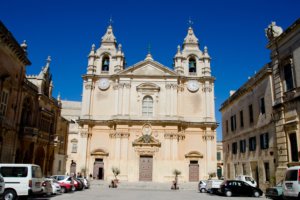The Rabat/Mdina neighbourhood is one of the most popular areas of Malta; this is hardly surprising when one considers the beautiful but contrasting scenery this area offers with Mdina offering urban, medieval architecture views while Rabat having an uncontested, rural charm. Apart from aesthetic, visual pleasure this neighbourhood offers much also to visitors who consider themselves history buffs. The area is in fact amongst those on the island that boasts non-stop occupation since the earliest of times which, considering its strategic and easily defendable location, available potable water and the fertility of the surrounding landscape is hardly surprising.

Mdina Metropolitan Cathedral
The first archaeological evidence of human occupation in Mdina goes back to the Bronze Age; however, this does not mean that the area was not also occupied during the Neolithic period around 7,000 years ago. The town, back then known as Melite, seems to have picked up in popularity during the Roman and later Byzantine period where it was also made the capital city of the island. Notwithstanding its land locked location, away from the harbours, Melite enjoyed substantial industrial commercial wealth and was part of intensified provincial trade routes within the Mediterranean region. The city was also much bigger than present day Mdina and extended as far out as the present St Paul’s church in present day Rabat which, coincidentally, was built on the ditch that surrounded the old capital city’s walls. The size of the town is also evidenced by the presence of the Roman Domus which would have been inside the city walls and, by St Paul’s Catacombs (a Roman period cemetery) a few metres outside the city walls. Present day Mdina owes much to the changes done by the Arabs following their takeover of the island in 870AD. During their occupation the city was reduced to its current size and the present day ditch was dug. Subsequent rulers added and amended the city as they saw fit leaving us with a medieval city which also boasts Norman architecture (a magnificent example of which is Palazzo Falson) and also Baroque architecture. This eclectic mix has resulted in a unique architectural gem which also frequently features in popular films and series, with perhaps the most famous of which is Game of Thrones.

Baroque architectural detail
Just outside Mdina one finds the rural village of Rabat. Once again the latter offers much in terms of historical points of interest and visual charm. It is also one of the few villages that have annexed to it a woodland area – Buskett. Rabat owes its name (it means suburb in Arabic) and its existence to the Arabs who, upon starting their rule on the island, split the previous sprawling capital city in two. Other consequences of this split include also the abandonment of the previous cemetery (St Paul’s Catacombs) and the digging of a new Muslim cemetery on the ground that was previously occupied by the Roman Domus. The Knights, who occupied the island around 660 years later , also left an indelible imprint on Rabat , even though their main residencies where placed in the new capital city, Valletta. One of their most noteworthy buildings is the ex-residence of the Chaplains of the Knights of St John with its finely sculpted baroque elements. This building, originally inaugurated in the early 1600s by Grand Master Alof de Wignacourt, currently houses the Wignacourt Museum. The latter offers to the discerning visitor: a collection of painted works by Mattia Preti, Antoine Favray and other European artists, silverware and also historical documents. The visit can be further supplemented with a look at the catacombs found under the museum.
Click here to book a private tour with Maltaprivateguide